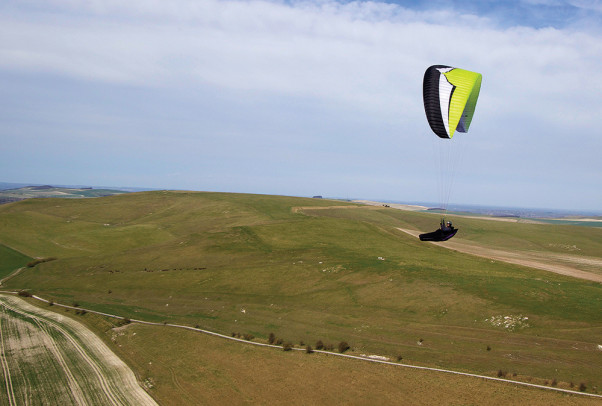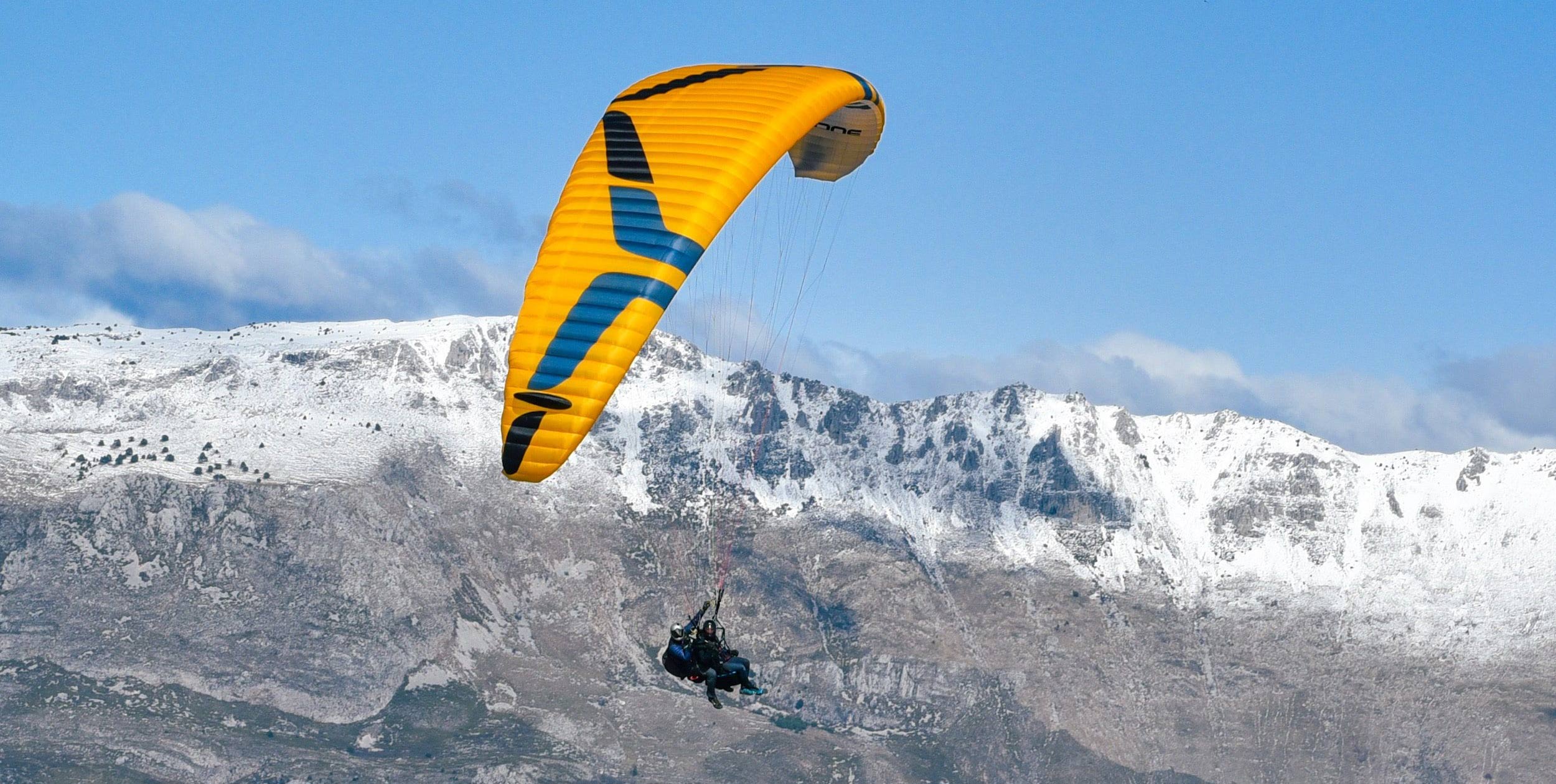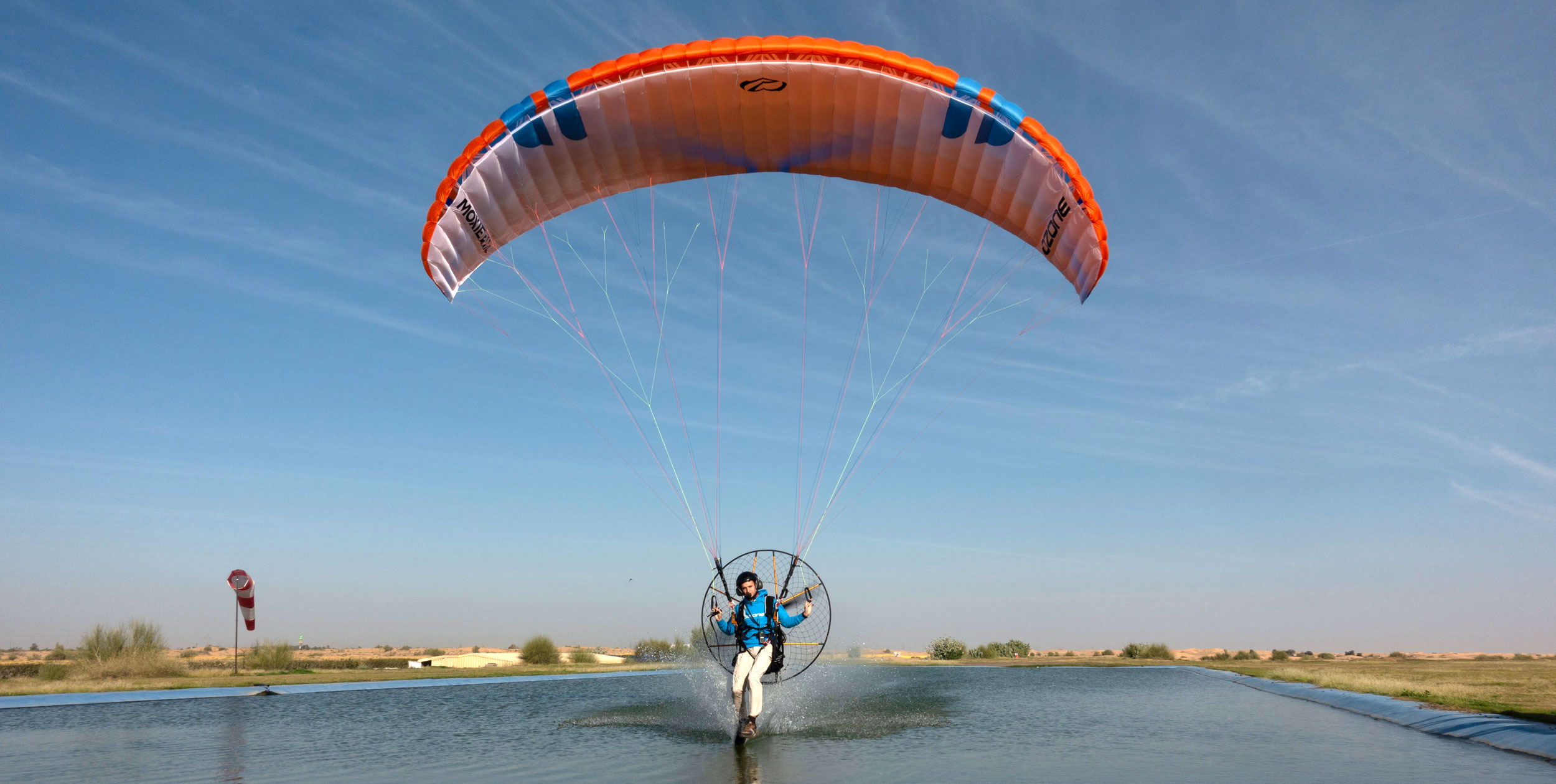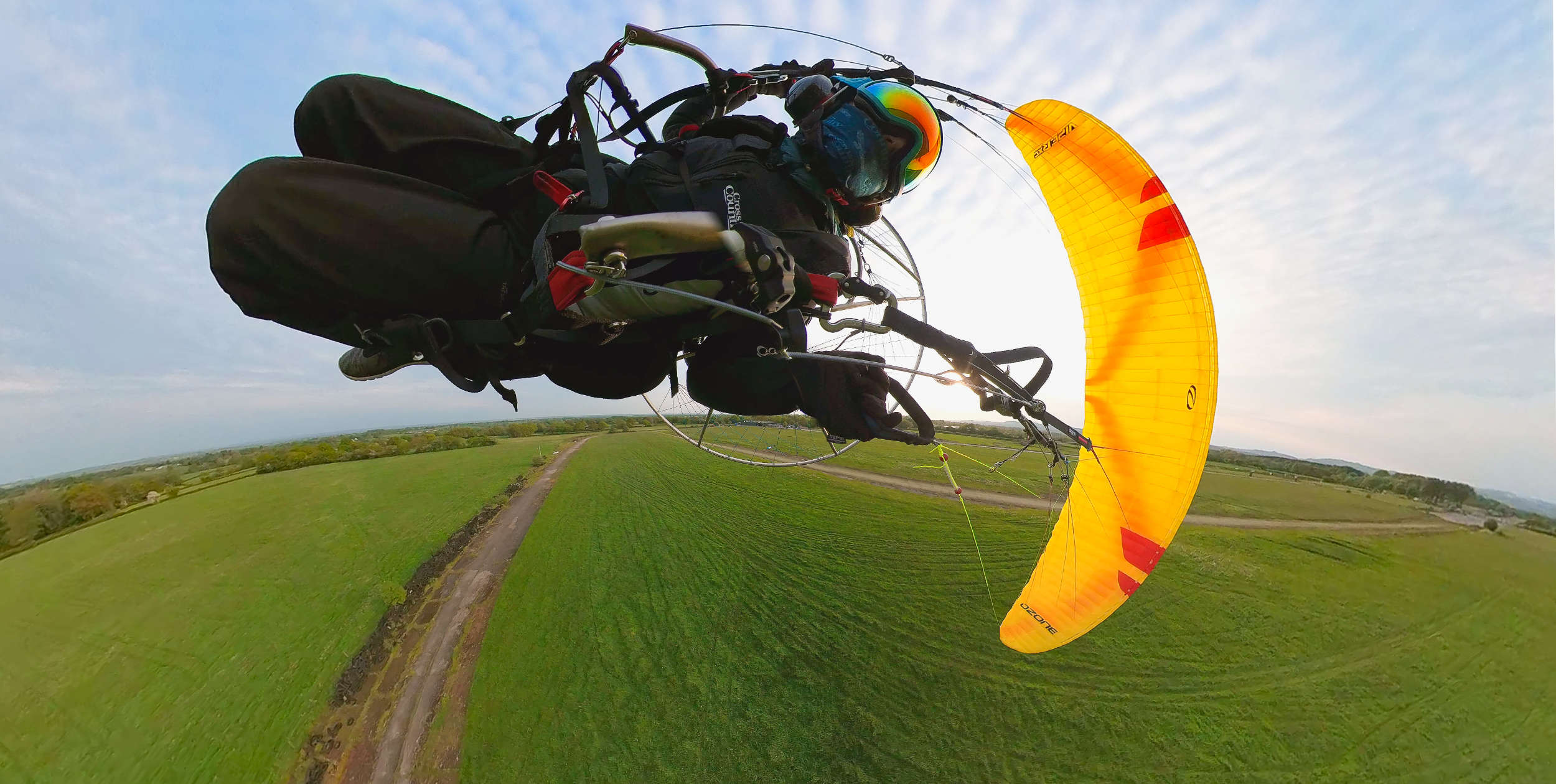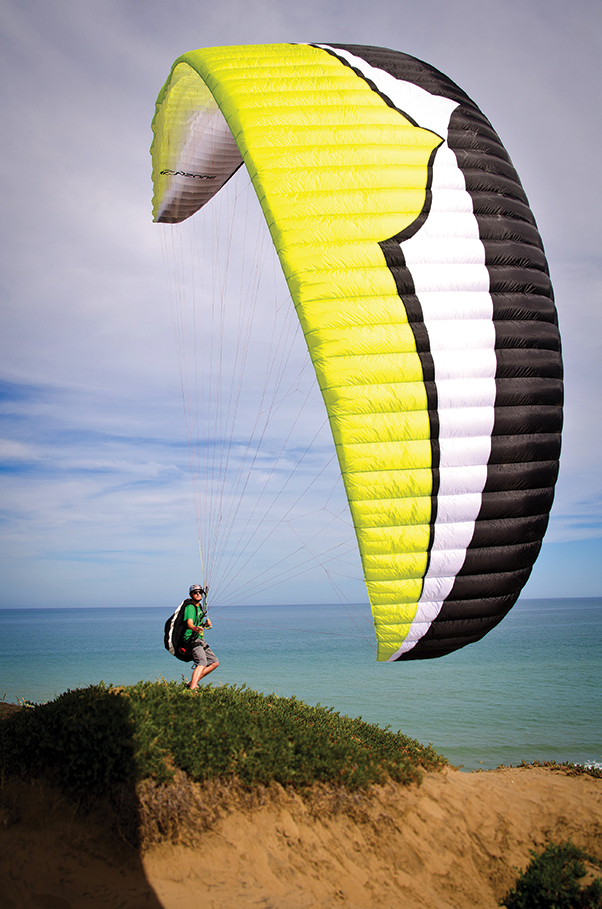
Ozone’s mission for the Delta 2 was: “To retain the comfort, safety, and ease of use of the original, but take the performance to the next level. In addition to that, we wanted to fine-tune the handling and cultivate a more fun and playful feel.”
Our reviewer agrees, saying it’s for mid- to top-end EN C pilots or those dropping down from EN D.
Features include refined sail tension and “the best features of the R11 shark nose”, Ozone say.
Photo: Ozone
Delta Force: It’s an unsheathed sports wing with added ‘Grrrr’, says Hugh Miller
Published in Cross Country issue 147
Let me set out my stall. I came to the Delta 2 after a long winter lay-off, and a good deal more wariness around the writing of reviews than I’ve ever had before – particularly when it comes to ranking wings on fast-and-dirty one-off glide comparisons or, ‘seemed to climb as well as an R11’ type judgements based on a couple of thermals, which frankly, are neither scientific or fair. All I can write about with honesty is a glider’s handling, usable speed and performance and thermalling and gliding qualities. These are what make up the character of a glider, and that’s what really interests me. And I’m just so lucky being able to fly each wing for a couple of months, to try and get beyond my immediate snap judgements, while many of us may be lucky to even get a single test flight on a wing before deciding whether to buy or not. It’s a privileged position. OK, on with the show.
Thermalling
The story begins under overcast March skies at Sharpenhoe Clappers, a titchy 70m high bowl in the UK flatlands. It’s my first flight on the Delta 2, and we’re all getting blown to bits in the strong wind, and I’m getting bored. I hook a scrabbly little climb and leave the hill only 100m above it to try and ride the bubble the four kilometres downwind to the train station and get myself home via London.
The first thing I discover about the Delta 2 is that it’s like a terrier, refusing to let go of the core. I just cling on and keep rotating, round and round, desperately trying to claw my way up. This low, everything’s close, the muddy fields, motorway, the approaching town – they’re only 160m below me, and I have no options at all. I can’t glide anywhere – I just have to circle and hope. It’s quite fun. I find that as long as I’m maintaining a consistent 360, I can get it banked up really tight and the Delta 2 still climbs, showing no tendency to dive into a spiral whatsoever. There’s something magic going on: it feels like the wing’s converting lots of the energy of the turn and lift into climb rate, which is exactly what I need when I’m in a scrap low down in a narrow, weak thermal. I decide I can’t give up this early in the season. Ten kilometres later, I’m still locked on and still hoping. Eventually the climb releases to a two-up, and I’m away.
Two weeks later and England looks like Spain in July. It’s a classic day, but I make some mistakes, and after 50km I end up low and with few options. I’m armed with confidence in the wing’s ability low down though, so I take a long necky glide through the blue to a small bonfire. I arrive at 100m, a leaf rushes past me, I smell smoke, the vario beeps – in we carve, and up we go. Six-hundred metres later I’m still being outclimbed by the leaf, but the Delta 2 performs impeccably.
If I need any more confirmation, it comes on my third day of testing. It’s a weak to nil-wind day, and we’re all waiting patiently on the southern slopes of Golden Ball, a 100m high ridge. I see two buzzards climbing out front, dive through sink to reach them, hit the lift, connect, and dial away. It takes very little thought or effort once I connect, I just keep circling. The Delta 2 is like a cat, digging its claws into a trouser leg, refusing to let go. It’s like playing one of those jet fighter video games where you’re tailing the enemy. As soon as you’re in range, the crosshairs flick to red, the ‘locked on’ symbol flashes, and it’s a sure-fire hit. It all feels so incredibly positive, and connected, and it’s what flying is all about for me.
Feel in turbulent air
As the climb develops, there are lots of nudges and movement through the brakes and risers to lead you to better air. I’d agree with Greg here with his ‘fish’ analogy. Where I’d differ though is that the build of the wing takes some getting used to, coming from other C’s (particularly ‘wriggly’ wings like the Aspen 4). The shark nose gives a far from conventional feel. It’s altogether more boxy, rigid and compact – the tension through the arc makes it feel like you’re driving a go-kart, low to the floor, feeling all the bumps – rather than the more cushioned and comfortable feel of say the Sigma 8 or Volt. There’s virtually no spanwise flexing to speak of: the whole wing stays locked and loaded.
Over the last two years women’s European open-distance holder Kirsty Cameron has flown both the shark-nosed R11 and conventional Enzo, and while her Enzo is always moving, she describes her R11 as feeling ‘planted’. The same could be said about the Delta 2 – ‘planted’ sums it up well. If anything, there’s a little less feedback through the risers and more through the brakes. On a Gin GTO for example, I’d feel one riser pull you up through your harness, and then know that that was the direction to turn. With the Delta 2 the feedback is a little more subtle, as the wing moves more as one.
It also seems incredibly positive in pitch: you simply pull into the thermal and roll into the core – then it’s like you’re in the garden, working the thermal like you might work the soil with a spade, digging in and pulling round. The wing sticks and grabs. I guess that’s what people mean by ‘good roll authority’.

Features include refined sail tension and “the best features of the R11 shark nose”, Ozone say.
Photo: Ozone
Handling while thermalling
Brake pressure is harder than many other Cs. After a five hour 140km XC, I’d wondered if my arms had wasted away from a winter indoors. The Delta 2 does demand more muscle than gliders such as the Mentor 2, Sigma 8 or Volt. If you like your handling to be really light and snappy, bear this in mind. Ozone test pilot Russ Ogden agrees it’s harder than the Delta, but placed it as “moderate firm”.
After my next five hour flight, I actually found I enjoyed the brake pressure. When thermalling, I found that squeezing only a couple of inches of extra brake would get the glider really whipping around. I flew the wing with a ‘conventional’ amount of brake – with a wrap, down around the karabiner on the inside brake, and up half-way between the pulleys and karabiner on the outside. Then on one climb, I let off the outside to put on my gloves, and found I actually climbed better with no outside brake and just a little inside. What do I know? Worth experimenting with if you’re testing one…

Ozone say the shark profile provides a more constant internal pressure in active air and turbulence, which increases collapse resistance. The result they say is a comfortable, stable feel in accelerated flight. The new profile has also improved the launch behaviour by reducing ‘shooting’ in stronger winds.
Photo: Ozone
On glide
I had some long glides on two of my cross country flights, some up to 15km long. Brakes-up, I noticed a tendency for the wing to ‘porpoise’ a little, getting pitched back by turbulence, then rocking forward – and this oscillation would build until I checked it with a dab of the brakes. This meant the gloves-off scamper-abouts – folding airmap, grabbing at chocolate bars and so on – had to be even quicker than usual. This is common among open class wings too – I have certainly noticed it on the Icepeak 6, but for sports pilots, it’s something worth taking note of.
The glider feels much more settled and sorted with a third speed bar on. It is designed to glide fast, bar on, mitts on the C-riser handles, feeling the air as you go. On half to full bar, feedback through the C-risers is fantastic, and the profile is very solid – similar in feel to the Volt. I had one ‘whooomp’ moment when the whole wing felt weightless, but the leading edge rode through it, holding its shape and allowing me to hold my nerve. I think it’ll take me some practice feeling the air and sensing thermals on glide, because each time I came off bar, my vario screamed lift to me. No doubt it’s a result of its efficiency but it’ll take some getting used to, particularly by pilots used to the relative inefficiency of Bs. This is where good Cs win out, without doubt.
Bar pressure on your legs is moderate, I’d say, but the speed builds quickly from the first small push, so you can play around with trimming with just a little bar. Don’t go pushing loads on your first test-flight: the wing responds quickly to small movements.
The profile tends to search forwards as you approach a climb, pulling into climbs with no tendency to mash back – it’s an eager companion, egging you on. And in a way, the ‘locked-in’ thermalling characteristics meant I had to remind myself to search out wider at times – other, ‘flatter’ handling wings kind of force you to do that, as they tend to go straight-and-level when you’re out of the core.
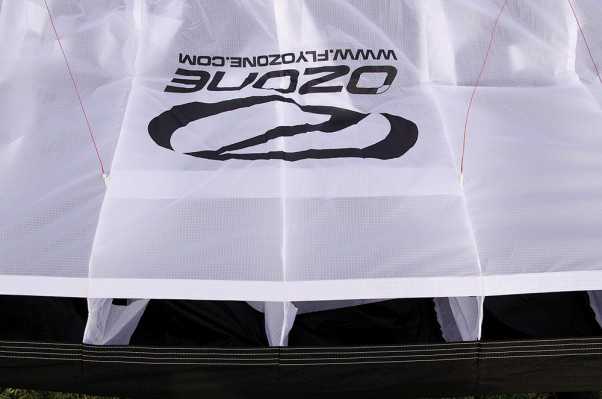
Ozone say the sail is cleaner than the Delta, with improvements made in panel shaping, reducing creases overall. Line optimisation has reduced the overall line-drag by 26%, Ozone say. Other improvements: the plastic rods are now replaceable.
In terms of glide performance, well I can’t really comment. I flew a long XC with Guy Anderson (Icepeak 6) and Kirsty (Enzo), and found it hard to keep up with them. Then on my next day, I did some into-wind glides with Kirsty and others, got some good lines and had no disadvantage. If you’re seriously into XC flying, don’t compete, and don’t mind the guys on their two-liners consistently getting away, then you’ll probably be as happy as I was with the Delta 2’s performance. It took me some time to settle into the wing and really get the most out of it – a good 15 hours or so.
Overall
I’ve now flown the Delta 2 over nearly 20 hours and had some truly fantastic XC flying on it, including a 140km downwinder and a 60km out-and-return – rare conditions in the UK. While trying to review the wing, I have changed my opinion about the glider after each of the four days out on it – which just goes to reinforce how important it is for me to spend a proper amount of time on a wing to really get to know it, otherwise it could just be first date lust or disgust.
A few months back I rated the Air Design Volt as my overall favourite C of the year for pilots stepping up from the EN B class. It’s a hard call, but I think it still is – mainly because I think it’s more accessible than the Delta 2 to low airtimers. It’s not that the Delta 2 has vices – I discovered none – more that I think, with this machine, Ozone has departed in a new direction. It’s a sports wing with added ‘Grrr’, designed for ambitious pilots in the mid- to top of the sports market and a fair chunk of the non-two-line ‘D’ market too.
It’s got an uncanny ability to hook into thermals low down and carry you up out of trouble, and has a huge amount of grunt on bar when you’ve got distance to cover. Having said that, if you are not yet regularly pushing bar on glides, why not just fly an EN B? The Delta 2 feels like it’s designed to be flown hard, and you will not reap any of its benefits unless you are ready to use its potential. In this respect the Delta 2 is a breed apart from the original in look, feel and appeal – so much so, it deserves a different name.
Mini R11, perhaps?
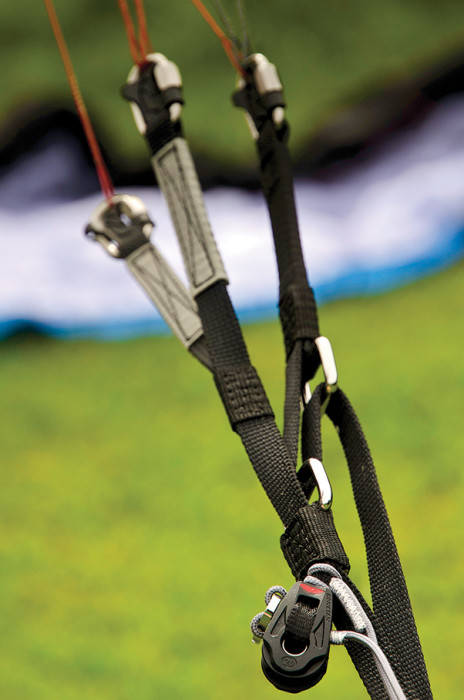
The risers include special C-toggles for C-riser control (not shown).
“To fly with the C risers, keep hold of your brake handles (remove any wraps) and take hold of the handles located at the top of the C risers. With the C risers you can fly actively through turbulence; If you feel the nose of the wing lose internal pressure you can apply pressure to the Cs to keep it open. The amount of pressure and size of the input is dependent upon the amount of turbulence, but always be gentle at first to learn the feel of the movement and to avoid large pitch oscillations,” explain Ozone.
‘It’s a little shark’
The Delta 2 offers fluid feedback through the risers, constantly shifting, in the best possible way – these movements don’t destabilise the wing in any axis, but the feedback allows you to sense all of the air’s movements. I found the subtle shifts required to follow lines of microlift upwind were easy to identify. The closest I can come to describing it is I felt like a slender fish, I could sense the gentle push and pull of the currents around me. A little shark, perhaps, gliding, searching, always hungry for lift? It certainly helps you to get the best out of every thermal. You can choose to ignore the feedback, or use it to your advantage. For the class, this is great. It might become a bit taxing in wild conditions or for inexperienced pilots, but it is an absolute brilliant glider for XC pilots and especially for weak conditions, where it’s all about subtlety and patience.
Gliding
At full speedbar the leading edge still shows the taut, sharp line that it displays at trim spin, with no noticeable deformations, a sign that it is tensioned and efficient. This is possibly due to the high arc which means the tips pull more outwards than upwards and even more so at speed. It didn’t feel critical – there is some tolerance remaining for turbulence. At speed it’s best to ride holding the little C handles, which are neat and perfectly shaped for the job, better than the oversized ‘badger bars’ or awkward ‘balls’ seen on other wings. Pulling the C handles offers reassuring tension and is your best defence against blow-outs.
Collapses
The asymmetric collapses I did behaved well, turning less than 90 degrees before reinflating without much fuss. However Ozone warns against inducing asymmetric collapses at full speed. The As are set back from the leading edge (‘deep As’), making it unlikely that an induced collapse will conform to the EN collapse angle, without the use of collapse lines. Being inquisitive, I induced a neat 50% collapse on full bar. The response could be best described using Ozone’s words: “aggressive, shock reinflation … and outside of EN”. With a collapse line, it scores an A for that manoeuvre. So you must be careful how you treat this highly tensioned high-arc deep-loaded wing.
Ozone’s Russell Ogden explained: “Most collapses break from the nose and roll backwards rather than being forced down as a block with a high kink angle and lots of air remaining inside.” He went on, “I have had several real life collapses on the Delta 2; one at full speed, whilst holding it at the max in thermic conditions without flying actively, the rest whilst thermaling at trim (accidentally). All of these recovered in a progressive spontaneous manner.”
The added stability caused by the deep As means it is unlikely you’ll see the nose tucking. Having flown a season in strong thermic conditions on another wing that uses deep A’s I’m convinced it is a beneficial design feature. Just be sure to hold onto those C-risers to keep the nose open in ugly air; they hold a good pressure.
Conclusion
For most experienced pilots who want a modern wing for exploring, adventuring, and having an absolute blast in the sky, the Delta 2 is a winner. It’s sensitive, sleek, stable and smooth. I have to stand up and applaud Ozone when they say, “We believe we have produced a truly superb wing.”
Greg Hamerton

